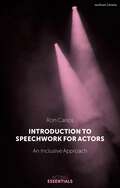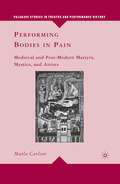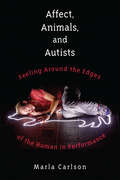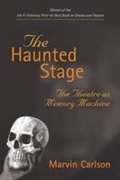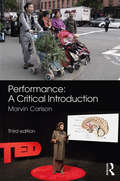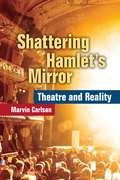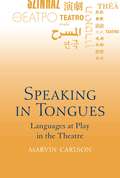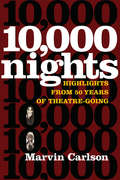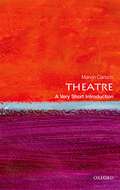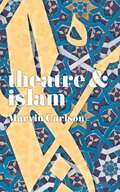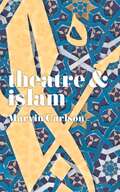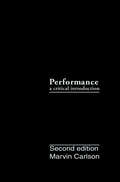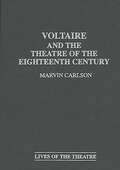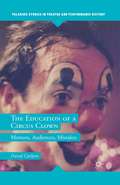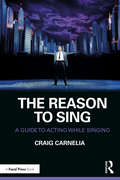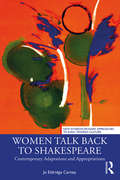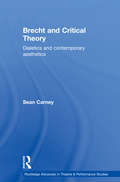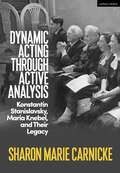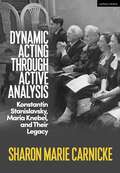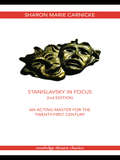- Table View
- List View
Introduction to Speechwork for Actors: An Inclusive Approach (Acting Essentials)
by Ron CarlosTraditional speech work has long favored an upper-class white accent as the model of intelligibility. Because of that, generations of actors have felt disconnected from their own identities and acting choices.This much-needed textbook redresses that trend and encourages actors to achieve intelligibility through rigorous language analysis and an exploration of their own accent and articulation practices.Following an acting class model, where you first analyze the script then reveal yourself through it, this work breaks down a process for analyzing language in a way that excites the imagination. Guiding the student through the labyrinth of abstract concepts and terms, readers are delivered into the practicality of exercises and explorations, giving them self-awareness that enables them to make their own speech come alive.Informed throughout by notes from the author's own extensive experience working with directors and acting teachers, this book serves as an ideal speech-training resource for the 21st -century actor, and includes specially commissioned online videos demonstrating key exercises.
Performing Bodies in Pain: Medieval and Post-Modern Martyrs, Mystics, and Artists (Palgrave Studies in Theatre and Performance History)
by M. CarlsonThis text analyzes the cultural work of spectacular suffering in contemporary discourse and late-medieval France, reading recent dramatizations of torture and performances of self-mutilating conceptual art against late-medieval saint plays.
Affect, Animals, and Autists: Feeling Around the Edges of the Human in Performance
by Marla CarlsonWhen theater and related forms of live performance explore the borderlands labeled animal and autism, they both reflect and affect their audiences’ understanding of what it means to be human. Affect, Animals, and Autists maps connections across performances that question the borders of the human whose neurodiverse experiences have been shaped by the diagnostic label of autism, and animal-human performance relationships that dispute and blur anthropocentric edges. By analyzing specific structures of affect with the vocabulary of emotions, Marla Carlson builds upon the conception of affect articulated by psychologist Silvan Tomkins. The book treats a diverse selection of live performance and archival video and analyzes the ways in which they affect their audiences. The range of performances includes commercially successful productions such as The Curious Incident of the Dog in the Night-Time, War Horse, and The Lion King as well as to the more avant-garde and experimental theater created by Robert Wilson and Christopher Knowles, Back to Back Theatre, Elevator Repair Service, Pig Iron Theatre, and performance artist Deke Weaver.
The Haunted Stage: The Theatre As Memory Machine (PDF)
by Marvin CarlsonThroughout theatrical history, almost every element in stage production has been recycled. Indeed any regular theatergoer is familiar with the experience of a performance that conjures the ghosts of previous productions. The Haunted Stage explores this theatrical d#65533;j#65533; vu, and examines how it stimulates the spectator's memory. Relating the dynamics of reception to the interaction between theater and memory, The Haunted Stage uncovers the ways in which the memory of the spectator informs the process of theatrical reception. Marvin Carlson is Sidney E. Cohn Distinguished Professor of Theatre and Comparative Literature at the City University of New York.
Performance: A Critical Introduction
by Marvin CarlsonSince its original publication in 1996, Marvin Carlson's Performance: A Critical Introduction has remained the definitive guide to understanding performance as a theatrical activity. It is an unparalleled exploration of the myriad ways in which performance has been interpreted, its importance to disciplines from anthropology to linguistics, and how it underpins essential concepts of human society. In this comprehensively revised and updated third edition, Carlson tackles the pressing themes and theories of our age, with expanded coverage of : the growth and importance of racial and ethnic performance; the emergence of performance concerned with age and disability; the popularity and significance of participatory and immersive theatre; the crucial relevance of identity politics and cultural performance in the twenty-first century. Also including a fully updated bibliography and glossary, this classic text is an invaluable touchstone for any student of performance studies, theatre history, and the performing and visual arts.
Shattering Hamlet's Mirror: Theatre and Reality
by Marvin CarlsonTheatrical playing, Hamlet famously averred, holds a mirror up to nature. But unlike the reflections in the mirror, the theater’s images are composed of real objects, most notably bodies, that have an independent existence outside the world of reflection. Throughout Western theater history there have been occasions when the reality behind the illusion was placed on display. In recent years theaters in Europe and North America have begun calling attention to the real in their work—presenting performers who did not create characters and who may not even have been actors, but who appeared on stage as themselves; texts created not by dramatic authors but drawn from real life; and real environments sometimes shared by actors and performers and containing real elements accessible to both. These practices, argues Marvin Carlson, constitute a major shift in the practical and phenomenological world of theater, and a turning away from mimesis, which has been at the heart of the theater since Aristotle. Shattering Hamlet's Mirror: Theatre and Reality examines recent and contemporary work by such groups as Rimini Protokoll, Societas Raffaelo Sanzio, the Gob Squad, Nature Theatre of Oklahoma, and Foundry Theatre, while revealing the deep antecedents of today’s theater, placing it in useful historical perspective. While many may consider it a post-postmodern phenomenon, the “theater of the real,” as it turns out, has very deep roots.
Speaking in Tongues: Languages at Play in the Theatre
by Marvin CarlsonSpeaking in Tongues presents a unique account of how language has been employed in the theatre, not simply as a means of communication but also as a stylistic and formal device, and for a number of cultural and political operations. The use of multiple languages in the contemporary theatre is in part a reflection of a more globalized culture, but it also calls attention to how the mixing of language has always been an important part of the functioning of theatre. The book begins by investigating various "levels" of language-high and low style, prose and poetry-and the ways in which these have been used historically to mark social positions and relationships. It next considers some of the political and historical implications of dialogue theatre, as well as theatre that literally employs several languages, from classical Greek examples to the postmodern era. Carlson treats with special attention the theatre of the postcolonial world, and especially the triangulation of the local language, the national language, and the colonial language, drawing on examples of theatre in the Caribbean, Africa, Australia, and New Zealand. Finally, Carlson considers the layering of languages in the theatre, such as the use of supertitles or simultaneous signing. Speaking in Tongues draws important social and political conclusions about the role of language in cultural power, making a vital contribution to the fields of theatre and performance. Marvin Carlson is Sidney E. Cohn Professor of Theatre and Comparative Literature, CUNY Graduate Center. He is author of Performance: A Critical Introduction; Theories of the Theatre: A Historical and Critical Survey, from the Greeks to the Present; and The Haunted Stage: The Theatre as Memory Machine, among many other books.
Ten Thousand Nights: Highlights from 50 Years of Theatre-Going
by Marvin CarlsonEsteemed scholar and theater aficionado Marvin Carlson has seen an unsurpassed number of theatrical productions in his long and distinguished career. Ten Thousand Nights is a lively chronicle of a half-century of theatre-going, in which Carlson recalls one memorable production for each year from 1960 to 2010. These are not conventional reviews, but essays using each theater experience to provide an insight into the theater and theatre-going at a particular time. The range of performances covered is broad, from edgy experimental fare to mainstream musicals, most of them based in New York but with stops at major theater events in Paris, Berlin, Moscow, Milan, and elsewhere. The engagingly written pieces convey a vivid sense not only of each production but also of the particular venue, neighborhood, and cultural context, covering nearly all significant movements, theater artists, and groups of the late twentieth century.
Theatre: Signs Of Life (Theatre And Ser.)
by Marvin CarlsonFrom before history was recorded to the present day, theatre has been a major artistic form around the world. From puppetry to mimes and street theatre, this complex art has utilized all other art forms such as dance, literature, music, painting, sculpture, and architecture. Every aspect of human activity and human culture can be, and has been, incorporated into the creation of theatre. In this Very Short Introduction Marvin Carlson takes us through Ancient Greece and Rome, to Medieval Japan and Europe, to America and beyond, and looks at how the various forms of theatre have been interpreted and enjoyed. Exploring the role that theatre artists play — from the actor and director to the designer and puppet-master, as well as the audience — this is an engaging exploration of what theatre has meant, and still means, to people of all ages at all times. ABOUT THE SERIES: The Very Short Introductions series from Oxford University Press contains hundreds of titles in almost every subject area. These pocket-sized books are the perfect way to get ahead in a new subject quickly. Our expert authors combine facts, analysis, perspective, new ideas, and enthusiasm to make interesting and challenging topics highly readable.
Theatre and Islam (Theatre And)
by Marvin CarlsonThis insightful and engaging new title in the Theatre & series explores the various connections between theatre and Islam. Drawing on both historical and recent examples to trace their relationship and offer a new perspective on a topical subject, this persuasive text argues against a long-standing assumption that Islam has worked in opposition to theatrical presentation. From the thirteenth century puppet plays of Ibn Daniyal to Islamic themes in twenty-first century productions, Theatre and Islam is chronologically wide-ranging and ambitious in its scope.Ambitious yet concise, this is the perfect introduction for undergraduate and postgraduate students of Religious Studies, Islamic Studies, Middle Eastern Studies and Drama.
Theatre and Islam (Theatre And)
by Marvin CarlsonThis insightful and engaging new title in the Theatre & series explores the various connections between theatre and Islam. Drawing on both historical and recent examples to trace their relationship and offer a new perspective on a topical subject, this persuasive text argues against a long-standing assumption that Islam has worked in opposition to theatrical presentation. From the 13th century puppet plays of Ibn Daniyal to Islamic themes in 21st century productions, Theatre and Islam is chronologically wide-ranging and ambitious in its scope.Ambitious yet concise, this is the perfect introduction for undergraduate and postgraduate students of religious studies, Islamic studies, Middle Eastern studies and drama.
Theatre: A Very Short Introduction (Very Short Introductions)
by Marvin CarlsonFrom before history was recorded to the present day, theatre has been a major artistic form around the world. From puppetry to mimes and street theatre, this complex art has utilized all other art forms such as dance, literature, music, painting, sculpture, and architecture. Every aspect of human activity and human culture can be, and has been, incorporated into the creation of theatre. In this Very Short Introduction Marvin Carlson takes us through Ancient Greece and Rome, to Medieval Japan and Europe, to America and beyond, and looks at how the various forms of theatre have been interpreted and enjoyed. Exploring the role that theatre artists play — from the actor and director to the designer and puppet-master, as well as the audience — this is an engaging exploration of what theatre has meant, and still means, to people of all ages at all times. ABOUT THE SERIES: The Very Short Introductions series from Oxford University Press contains hundreds of titles in almost every subject area. These pocket-sized books are the perfect way to get ahead in a new subject quickly. Our expert authors combine facts, analysis, perspective, new ideas, and enthusiasm to make interesting and challenging topics highly readable.
Performance: A Critical Introduction (PDF)
by Marvin A. CarlsonThis comprehensively revised, illustrated edition discusses recent performance work and takes into consideration changes that have taken place since the book's original publication in 1996. Marvin Carlson guides the reader through the contested definition of performance as a theatrical activity and the myriad ways in which performance has been interpreted by ethnographers, anthropologists, linguists, and cultural theorists. Topics covered include: *the evolution of performance art since the 1960s *the relationship between performance, postmodernism, the politics of identity, and current cultural studies *the recent theoretical developments in the study of performance in the fields of anthropology, psychoanalysis, linguistics, and technology. With a fully updated bibliography and additional glossary of terms, students of performance studies, visual and performing arts or theatre history will welcome this new version of a classic text.
Performance: A Critical Introduction
by Marvin A. CarlsonThis comprehensively revised, illustrated edition discusses recent performance work and takes into consideration changes that have taken place since the book's original publication in 1996. Marvin Carlson guides the reader through the contested definition of performance as a theatrical activity and the myriad ways in which performance has been interpreted by ethnographers, anthropologists, linguists, and cultural theorists. Topics covered include: *the evolution of performance art since the 1960s *the relationship between performance, postmodernism, the politics of identity, and current cultural studies *the recent theoretical developments in the study of performance in the fields of anthropology, psychoanalysis, linguistics, and technology. With a fully updated bibliography and additional glossary of terms, students of performance studies, visual and performing arts or theatre history will welcome this new version of a classic text.
Voltaire and the Theatre of the Eighteenth Century (Contributions in Drama and Theatre Studies: Lives of the Theatre)
by Marvin A. CarlsonBorn in the final years of the seventeenth century, and dying a decade before the beginning of the French Revolution, Voltaire was a quintessential figure of the eighteenth century, so much so that this era is sometimes called the Age of Voltaire. At a time when French culture dominated Europe, Voltaire dominated French culture. His influence was broad and powerful, and he made major contributions to almost every sphere of intellectual activity, including the sciences, trade and commerce, politics, and especially the arts. Despite the astonishing range of his literary activities, the theatre occupied a central position in his life from the beginning of his career to its close. His first and last literary triumphs were plays, the first written when he was only 17, the last completed when he was 84. He created a total of 56, and there was rarely a time in his life when he was not working on a theatrical script. At the end of his career, his works were produced more frequently on the French stage than those of any other serious dramatist and served as models for aspiring young playwrights throughout Europe.Written by a leading authority on French theatre and culture in the eighteenth century, this book traces the theatrical career of Voltaire from his college days through his final works. The most influential dramatist of the period, he successfully wrote in a number of genres, including tragedy, comedy, opera, comic opera, and court spectacle. His theatrical biography involves all aspects of acting and staging in amateur and society theatre as well as on major professional stages and performances at court. His extended visits to England and Germany are covered in chapters that also provide an introduction to the theatre in those countries, and his international interests and correspondence provide insights into the eighteenth century theatre in places such as Italy, Russia, and Denmark. Due to his literally life-long concern with the theatre, his dominance in this art, and his reputation and involvement with the theatre outside France, Voltaire's theatrical biography is also in large measure a chronicle of the European stage of the eighteenth century.
The Education of a Circus Clown: Mentors, Audiences, Mistakes (Palgrave Studies in Theatre and Performance History)
by David Carlyon2017 Freedley Award Finalist, Theatre Library Association 2016 Best Circus Book of the Year, Stuart Thayer Prize, Circus Historical Society The 1960s American hippie-clown boom fostered many creative impulses, including neo-vaudeville and Ringling's Clown College. However, the origin of that impulse, clowning with a circus, has largely gone unexamined. David Carlyon, through an autoethnographic examination of his own experiences in clowning, offers a close reading of the education of a professional circus clown, woven through an eye-opening, sometimes funny, occasionally poignant look at circus life. Layering critical reflections of personal experience with connections to wider scholarship, Carlyon focuses on the work of clowning while interrogating what clowns actually do, rather than using them as stand-ins for conceptual ideas or as sentimental figures.
The Reason to Sing: A Guide to Acting While Singing
by Craig CarneliaIn The Reason to Sing, renowned composer-lyricist and teacher Craig Carnelia provides musical actors with a step-by-step guide to making their singing performances more truthful, vivid, and full of life. Using a technique developed over decades of teaching the professional community of Broadway actors and students alike, The Reason to Sing utilizes detailed descriptions of sessions the author has had with his notable students and lays out a new and proven approach to help you build your skills, your confidence, and your career. This book is intended for musical theater acting students as well as working professionals and teachers of the craft.
The Reason to Sing: A Guide to Acting While Singing
by Craig CarneliaIn The Reason to Sing, renowned composer-lyricist and teacher Craig Carnelia provides musical actors with a step-by-step guide to making their singing performances more truthful, vivid, and full of life. Using a technique developed over decades of teaching the professional community of Broadway actors and students alike, The Reason to Sing utilizes detailed descriptions of sessions the author has had with his notable students and lays out a new and proven approach to help you build your skills, your confidence, and your career. This book is intended for musical theater acting students as well as working professionals and teachers of the craft.
Women Talk Back to Shakespeare: Contemporary Adaptations and Appropriations (New Interdisciplinary Approaches to Early Modern Culture)
by Jo Eldridge CarneyThis study explores more recent adaptations published in the last decade whereby women—either authors or their characters—talk back to Shakespeare in a variety of new ways. "Talking back to Shakespeare", a term common in intertextual discourse, is not a new phenomenon, particularly in literature. For centuries, women writers—novelists, playwrights, and poets—have responded to Shakespeare with inventive and often transgressive retellings of his work. Thus far, feminist scholarship has examined creative responses to Shakespeare by women writers through the late twentieth century. This book brings together the "then" of Shakespeare with the "now" of contemporary literature by examining how many of his plays have cultural currency in the present day. Adoption and surrogate childrearing; gender fluidity; global pandemics; imprisonment and criminal justice; the intersection of misogyny and racism—these are all pressing social and political concerns, but they are also issues that are central to Shakespeare’s plays and the early modern period. By approaching material with a fresh interdisciplinary perspective, Women Talk Back to Shakespeare is an excellent tool for both scholars and students concerned with adaptation, women and gender, and intertextuality of Shakespeare’s plays.
Women Talk Back to Shakespeare: Contemporary Adaptations and Appropriations (New Interdisciplinary Approaches to Early Modern Culture)
by Jo Eldridge CarneyThis study explores more recent adaptations published in the last decade whereby women—either authors or their characters—talk back to Shakespeare in a variety of new ways. "Talking back to Shakespeare", a term common in intertextual discourse, is not a new phenomenon, particularly in literature. For centuries, women writers—novelists, playwrights, and poets—have responded to Shakespeare with inventive and often transgressive retellings of his work. Thus far, feminist scholarship has examined creative responses to Shakespeare by women writers through the late twentieth century. This book brings together the "then" of Shakespeare with the "now" of contemporary literature by examining how many of his plays have cultural currency in the present day. Adoption and surrogate childrearing; gender fluidity; global pandemics; imprisonment and criminal justice; the intersection of misogyny and racism—these are all pressing social and political concerns, but they are also issues that are central to Shakespeare’s plays and the early modern period. By approaching material with a fresh interdisciplinary perspective, Women Talk Back to Shakespeare is an excellent tool for both scholars and students concerned with adaptation, women and gender, and intertextuality of Shakespeare’s plays.
Brecht and Critical Theory: Dialectics and Contemporary Aesthetics (Routledge Advances in Theatre & Performance Studies #2)
by Sean CarneyArguing that Brecht’s aesthetic theories are still highly relevant today, and that an appreciation of his theory and theatre is essential to an understanding of modern critical theory, this book examines the influence of Brecht’s aesthetic on the pre-eminent materialist critics of the twentieth century: Louis Althusser, Walter Benjamin, Roland Barthes, Frederic Jameson, Theodor W. Adorno and Raymond Williams. Re-reading Brecht through the lens of post-structuralism, Sean Carney asserts that there is a Lacanian Brecht and a Derridean Brecht: the result of which is a new Brecht whose vital importance for the present is located in decentred theories of subjectivity. Brecht and Critical Theory maps the many ways in which Brechtian thinking pervades critical thought today, informing the critical tools and stances that make up the contemporary study of aesthetics.
Brecht and Critical Theory: Dialectics and Contemporary Aesthetics (Routledge Advances in Theatre & Performance Studies)
by Sean CarneyArguing that Brecht’s aesthetic theories are still highly relevant today, and that an appreciation of his theory and theatre is essential to an understanding of modern critical theory, this book examines the influence of Brecht’s aesthetic on the pre-eminent materialist critics of the twentieth century: Louis Althusser, Walter Benjamin, Roland Barthes, Frederic Jameson, Theodor W. Adorno and Raymond Williams. Re-reading Brecht through the lens of post-structuralism, Sean Carney asserts that there is a Lacanian Brecht and a Derridean Brecht: the result of which is a new Brecht whose vital importance for the present is located in decentred theories of subjectivity. Brecht and Critical Theory maps the many ways in which Brechtian thinking pervades critical thought today, informing the critical tools and stances that make up the contemporary study of aesthetics.
Dynamic Acting through Active Analysis: Konstantin Stanislavsky, Maria Knebel, and Their Legacy
by Sharon Marie CarnickeIn the 21st century, actors face radical changes in plays and performance styles, as they move from stage to screen and grapple with new technologies that present their art to ever-expanding audiences. Active Analysis offers the flexibility of mind, body, and spirit now urgently needed in acting. Dynamic Acting through Active Analysis brings to light this timely legacy, born during the worst era of Soviet repression and hidden for decades from public view. Part I unfolds like a mystery novel through letters, memoirs, and transcripts of Konstantin Stanislavsky's last classes. Far from the authoritarian director of his youth, he reveals himself as a generous mentor, who empowers actors with a brand new collaborative approach to rehearsals. His assistant, Maria Knebel, first bears witness to his forward-looking ideas and then builds the bridge to new plays in new styles through her directing and influential teaching. Part II follows a 21st century company of diverse actors as they experience the joy of applying Active Analysis to their own creative and professional work.
Dynamic Acting through Active Analysis: Konstantin Stanislavsky, Maria Knebel, and Their Legacy
by Sharon Marie CarnickeIn the 21st century, actors face radical changes in plays and performance styles, as they move from stage to screen and grapple with new technologies that present their art to ever-expanding audiences. Active Analysis offers the flexibility of mind, body, and spirit now urgently needed in acting. Dynamic Acting through Active Analysis brings to light this timely legacy, born during the worst era of Soviet repression and hidden for decades from public view. Part I unfolds like a mystery novel through letters, memoirs, and transcripts of Konstantin Stanislavsky's last classes. Far from the authoritarian director of his youth, he reveals himself as a generous mentor, who empowers actors with a brand new collaborative approach to rehearsals. His assistant, Maria Knebel, first bears witness to his forward-looking ideas and then builds the bridge to new plays in new styles through her directing and influential teaching. Part II follows a 21st century company of diverse actors as they experience the joy of applying Active Analysis to their own creative and professional work.
Stanislavsky in Focus: An Acting Master for the Twenty-First Century
by Sharon Marie CarnickeFirst published in 1998. Routledge is an imprint of Taylor & Francis, an informa company.
